Laina Turner's Blog, page 24
June 9, 2017
Book Expo 2017
I’ve been attending conferences my entire professional life. None as awesome as this one.
I can say hands down, that Book Expo America was the most transformational and impactful to my career as an author.
And I got 13 books to take home and read. Seriously, can’t get better than that!
I’d wanted to attend this conference for several years now. The timing never worked out until this year. I will tell you that for sure I will be making the timing work in the future. There’s no way I’ll miss this conference again.
So what is Book Expo America? Here is the description from their website:
BookExpo is evolving to lead the global publishing industry to its consumer-driven future and celebrate storytelling in all its forms.
It’s the place where industry, authors, and readers converge to define the new publishing universe.
BookExpo provides a focused professional environment to discover emerging authors and the next blockbuster titles, engage with the world’s most influential publishers and learn from industry leaders and peers.
In my words, it started as a publishing conference but has evolved over the years to include more for the self-published author.
Like me. Like YOU! Like all us indies.
I’d always wanted to go because it seemed awesome to be so close to all the amazing authors who attend it.
It is the #1 conference of its type in America.
Not only were there a million books that were in the area called The Book Marketplace, hoping to be picked up by store owners and librarians, but the education sessions were jam packed with great information.
I wanted to clone myself to be able to attend tracks running simultaneously there were so many good ones to choose from.
It was so beneficial because there were topics discussed from many different angles, giving me a great perspective.
The conference isn’t aimed specifically at us Indie Authors, but we would be silly not to realize how much we could learn from the big dogs. I got to listen to panel discussions about how publishers were using the same methods we all use to gain exposure and great sales for their authors.
It gave me so much validation that I was doing things right.
As I’ve mentioned before marketing falls heavily on big-name authors just as much as it does on us little guys. The main difference is they can usually pay for more help then we can.
But we will get there!
To hear how the traditionally published authors are using tools such as Goodreads and Facebook live was incredibly encouraging to me because it reinforced my belief that we all have the ability to be successful. There isn’t some magic formula out there.
It’s a lot of hard work and hustle.
The conference went Wednesday – Friday, but I didn’t get into NYC until later Wednesday, so I got to the conference center bright and early on Thursday.
I wasn’t the only one who had that idea because an hour before the doors opened and there was already a long line. Since I’m not a fan of lines, I decided to find a coffee shop and wait until a little after 8 am when the crowd that was waiting would disperse.
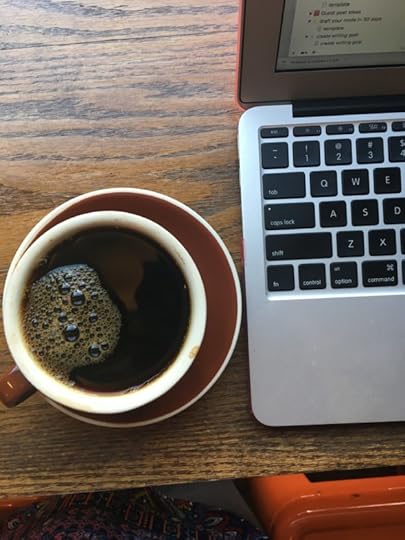
It was a good plan. I was able to enjoy a great pour-over coffee and pastry and still get to the conference center, get registered, and make my way to the author panel breakfast only a few minutes late.
It was a great way to start my day. I got to listen to authors tell a little about themselves and how they got the ideas for their stories. And imagine my surprise when I left the room and books by these authors were being passed out. ARC copies. Books that won’t even be available to the public for months, some not until next year.
I resisted the urge to sit down right there and start reading my free books. I wanted to make my way to the author stage for the first educational session.
I love how they organized the sessions. So often you go to conferences, and the sessions are an hour long, and it can be so hard to pay attention after the first 20 minutes or so. Not because the speaker isn’t interesting but because let’s face it. Our attention span these days isn’t all the long. At least mine isn’t.
The author panels were 50 minutes, and a couple of the sessions were longer, but the majority of the ones I had on my schedule to attend were 20 minutes long. It was perfect. Most of the speakers jammed a ton of great information in this small time frame. I got so much value. Because they were one right after another, I was giddy with how much great information I was picking up, and I’ve got pages of notes.
In hindsight, I’m glad that first day I went to get coffee instead of standing in line because it was non-stop until lunch. And even though there were 2 Starbucks in Javits Center the lines were CRAZY!
When I finally got a break and started walking around, I was in heaven. The books. The amazing volume of books, after books, after books. Even thought it wasn’t a bookstore where I could buy things (thank god for that, I’d be broke) for someone who loves books it was heaven.
Then when people started shoving books in my hand to take I was beside myself. There were many authors there doing book signings and publishers promoting them and giving away ARC copies. The ARC copies are so cool because they have marketing info and such on the back. I felt like such an insider.
And when I got home my kids thought I was important to have them.
My top takeaways from this were:
The publishing industry has changed, is changing, and will continue to change. Us authors will direct the future of this industry now more than ever.
The Indie Author has the same potential as a big name author. Instead of thinking of the resources we don’t have we need to think about all we do have.
Fan engagement is key. Email list building is key (you’ve heard me say that a time or two).
Putting out an amazingly perfect product is how you will compete.
The experience was more than worth the $500 conference price tag. Even when I add in the travel expenses, it was totally worth it. I came away feeling empowered, inspired, and more importantly authentic.
There is no better time than now to start your journey to being a full-time author.
The post Book Expo 2017 appeared first on Laina Turner.

June 8, 2017
Define Your Ideal Reader
When promoting your book, it’s important to know and understand who your ideal reader is.
Yes, that is often decided by genre to a point. It’s not like you’re going to try to target men 20-30 who play video games to sell your romance novel too. I mean you could, but I doubt it would sell you a lot of books.
But when creating a successful marketing campaign, you need to have a very specific target market.
As an author that target is your IDEAL READER.
You want to be more specific than all women who read.
Determining that right market is based on you the author and of course your book. You want to relate to your audience in some way. Whether it is demographic, topical, location, or interests.
Find where your genre demographic and your own personal demographic intersect and use that as a starting point.
For example. I’m 40 something, mom; I like yoga, coffee, and wine. When I’m not writing my novels or writing about writing, I write about those things, which interest me. This helps me connect on a more personal level with readers who have similar interests. It allows me to narrow my target to people who share those interests as well as who love to read cozy mysteries. It gives me a way to connect with readers on many levels.
When I’m thinking about my author platform as a whole, I take that into consideration. There are enough readers out there for everyone. I want to target those who are most like me and write my blog posts and social media posts with them in mind. It’s hard enough to connect with people in the virtual world without an idea of who you want to connect with.
When you are working on defining your target audience, it helps to paint a mental picture. Even better a real picture. That’s what I do.
Not literally paint, because I can’t paint to save my life. I picture in my head that that ideal person is who would be interested in reading my books and I write out a very vivid description of her.
I then go a step further and look in one of my many magazines (I have an addiction) and do the old fashioned thing of cutting out images. Those I paste to blank paper to give me that visual, which I put on my office wall.
I do realize there are many high tech ways of doing this exercise nowadays but sometimes nothing beats the tactical process of cutting and pasting. At least in my opinion.
I’m then able to keep this visual of my ideal audience front of mind as I write my novels, my blog, and my social media.
Define Your Ideal Reader Worksheet

Subscribe to get our latest content by email.
Success! Now check your email to confirm your download.
There was an error submitting your subscription. Please try again.
First Name Email Address We use this field to detect spam bots. If you fill this in, you will be marked as a spammer. Subscribe We won't send you spam. Unsubscribe at any time. Powered by ConvertKit /* Layout */ .ck_form { /* divider image */ background: #fff url(data:image/gif;base64,R0lGODlhAQADAIABAMzMzP///yH/C1hNUCBEYXRhWE1QPD94cGFja2V0IGJlZ2luPSLvu78iIGlkPSJXNU0wTXBDZWhpSHpyZVN6TlRjemtjOWQiPz4gPHg6eG1wbWV0YSB4bWxuczp4PSJhZG9iZTpuczptZXRhLyIgeDp4bXB0az0iQWRvYmUgWE1QIENvcmUgNS41LWMwMTQgNzkuMTUxNDgxLCAyMDEzLzAzLzEzLTEyOjA5OjE1ICAgICAgICAiPiA8cmRmOlJERiB4bWxuczpyZGY9Imh0dHA6Ly93d3cudzMub3JnLzE5OTkvMDIvMjItcmRmLXN5bnRheC1ucyMiPiA8cmRmOkRlc2NyaXB0aW9uIHJkZjphYm91dD0iIiB4bWxuczp4bXA9Imh0dHA6Ly9ucy5hZG9iZS5jb20veGFwLzEuMC8iIHhtbG5zOnhtcE1NPSJodHRwOi8vbnMuYWRvYmUuY29tL3hhcC8xLjAvbW0vIiB4bWxuczpzdFJlZj0iaHR0cDovL25zLmFkb2JlLmNvbS94YXAvMS4wL3NUeXBlL1Jlc291cmNlUmVmIyIgeG1wOkNyZWF0b3JUb29sPSJBZG9iZSBQaG90b3Nob3AgQ0MgKE1hY2ludG9zaCkiIHhtcE1NOkluc3RhbmNlSUQ9InhtcC5paWQ6MUQ5NjM5RjgxQUVEMTFFNEJBQTdGNTQwMjc5MTZDOTciIHhtcE1NOkRvY3VtZW50SUQ9InhtcC5kaWQ6MUQ5NjM5RjkxQUVEMTFFNEJBQTdGNTQwMjc5MTZDOTciPiA8eG1wTU06RGVyaXZlZEZyb20gc3RSZWY6aW5zdGFuY2VJRD0ieG1wLmlpZDoxRDk2MzlGNjFBRUQxMUU0QkFBN0Y1NDAyNzkxNkM5NyIgc3RSZWY6ZG9jdW1lbnRJRD0ieG1wLmRpZDoxRDk2MzlGNzFBRUQxMUU0QkFBN0Y1NDAyNzkxNkM5NyIvPiA8L3JkZjpEZXNjcmlwdGlvbj4gPC9yZGY6UkRGPiA8L3g6eG1wbWV0YT4gPD94cGFja2V0IGVuZD0iciI/PgH//v38+/r5+Pf29fTz8vHw7+7t7Ovq6ejn5uXk4+Lh4N/e3dzb2tnY19bV1NPS0dDPzs3My8rJyMfGxcTDwsHAv769vLu6ubi3trW0s7KxsK+urayrqqmop6alpKOioaCfnp2cm5qZmJeWlZSTkpGQj46NjIuKiYiHhoWEg4KBgH9+fXx7enl4d3Z1dHNycXBvbm1sa2ppaGdmZWRjYmFgX15dXFtaWVhXVlVUU1JRUE9OTUxLSklIR0ZFRENCQUA/Pj08Ozo5ODc2NTQzMjEwLy4tLCsqKSgnJiUkIyIhIB8eHRwbGhkYFxYVFBMSERAPDg0MCwoJCAcGBQQDAgEAACH5BAEAAAEALAAAAAABAAMAAAICRFIAOw==) repeat-y center top; font-family: "Helvetica Neue", Helvetica, Arial, Verdana, sans-serif; line-height: 1.5em; overflow: hidden; color: #666; font-size: 16px; border-top: solid 20px #3071b0; border-top-color: #ff8598; border-bottom: solid 10px #3d3d3d; border-bottom-color: #99505b; -webkit-box-shadow: 0px 0px 5px rgba(0,0,0,.3); -moz-box-shadow: 0px 0px 5px rgba(0,0,0,.3); box-shadow: 0px 0px 5px rgba(0,0,0,.3); clear: both; margin: 20px 0px; } .ck_form, .ck_form * { -webkit-box-sizing: border-box; -moz-box-sizing: border-box; box-sizing: border-box; } #ck_subscribe_form { clear: both; } /* Element Queries — uses JS */ .ck_form_content, .ck_form_fields { width: 50%; float: left; padding: 5%; } .ck_form.ck_horizontal { } .ck_form_content { border-bottom: none; } .ck_form.ck_vertical { background: #fff; } .ck_vertical .ck_form_content, .ck_vertical .ck_form_fields { padding: 10%; width: 100%; float: none; } .ck_vertical .ck_form_content { border-bottom: 1px dotted #aaa; overflow: hidden; } /* Trigger the vertical layout with media queries as well */ @media all and (max-width: 499px) { .ck_form { background: #fff; } .ck_form_content, .ck_form_fields { padding: 10%; width: 100%; float: none; } .ck_form_content { border-bottom: 1px dotted #aaa; } } /* Content */ .ck_form_content h3 { margin: 0px 0px 15px; font-size: 24px; padding: 0px; } .ck_form_content p { font-size: 14px; } .ck_image { float: left; margin-right: 5px; } /* Form fields */ .ck_errorArea { display: none; } #ck_success_msg { padding: 10px 10px 0px; border: solid 1px #ddd; background: #eee; } .ck_label { font-size: 14px; font-weight: bold; } .ck_form input[type="text"], .ck_form input[type="email"] { font-size: 14px; padding: 10px 8px; width: 100%; border: 1px solid #d6d6d6; /* stroke */ -moz-border-radius: 4px; -webkit-border-radius: 4px; border-radius: 4px; /* border radius */ background-color: #f8f7f7; /* layer fill content */ margin-bottom: 5px; height: auto; } .ck_form input[type="text"]:focus, .ck_form input[type="email"]:focus { outline: none; border-color: #aaa; } .ck_checkbox { padding: 10px 0px 10px 20px; display: block; clear: both; } .ck_checkbox input.optIn { margin-left: -20px; margin-top: 0; } .ck_form .ck_opt_in_prompt { margin-left: 4px; } .ck_form .ck_opt_in_prompt p { display: inline; } .ck_form .ck_subscribe_button { width: 100%; color: #fff; margin: 10px 0px 0px; padding: 10px 0px; font-size: 18px; background: #ff8598; -moz-border-radius: 4px; -webkit-border-radius: 4px; border-radius: 4px; /* border radius */ cursor: pointer; border: none; text-shadow: none; } .ck_form .ck_guarantee { color: #626262; font-size: 12px; text-align: center; padding: 5px 0px; display: block; } .ck_form .ck_powered_by { display: block; color: #aaa; } .ck_form .ck_powered_by:hover { display: block; color: #444; } .ck_converted_content { display: none; padding: 5%; background: #fff; }I treat my ideal reader as a friend because she is. A really good friend who wants to read what I have to say as long as I keep it interesting. Keeping her in my head when writing makes sure that I don’t stray too far from my target audience. Which can be easy to do if you’re like me and have a million “great” ideas floating around in your head at all times. It can be hard to stay focused.
Which can be easy to do if you’re like me and have a million “great” ideas floating around in your head at all times. It can be hard to stay focused.
Most of us have a general idea who our target is but how can you narrow it down further and figure out exactly who your target market is?
You can start by stating the premise statement (if you want more info on what a book premise statement is you can read my blog post here) of your book and then asking yourself some questions. Be as specific as possible.
Be as specific as possible.
What’s your genre?
What subjects do your books cover? This could be the main characters profession, or the setting, or the general theme. For example, my main character of my Presley series loves coffee and wine. Surprise, so do I. I weave that into a lot that I do.
Who would those subjects appeal too?
Who are the audiences of similar books?
What elements are in your main story that would appeal to someone?
One of my fav authors, Heather Wardell, has several books set in Toronto. I haven’t been since I was a child but often went with my parents and loved reading about the city. Even though it’s a very small aspect of her novels.
What’s the age demographic based on your characters?
Same question as above but use gender.
Now, look at your mission and the answers to the questions. See what kind of patterns you can see. You should have a list of traits your books have potential readers have in common. Using the information you’ve gathered start to write out the description of your ideal reader. It doesn’t have to include every single element, but you want to hit on a few. These are the threads that will connect you to your readers.
These are the threads that will connect you to your readers.
When you think you have solidified your target audience, you can execute your marketing plan and see if it sticks. If people don’t seem interested in what you have to say then you might need to revisit who you are zoning in on and make adjustments.
Don’t be frustrated if your first attempt doesn’t give you the results you were hoping for. It can take a lot of trial and error to get that perfect target audience and see results of your marketing efforts.
This will be an ever-evolving process for as long as your an author.
Let me know below in the comments if you have any questions!
The post Define Your Ideal Reader appeared first on Laina Turner.

June 7, 2017
Healthy Lifestyle: consistency is key
I am one of those people who can get caught up in the intense excitement of the moment.
That can mean agreeing to something that I normally wouldn’t agree too if I took the time to rationally and logically think about what I was getting myself into.
That is how I decide to sign up for the Spartan Race that’s happening in July. July 8th to be exact which is WAY TO CLOSE!!
When I get back from my trip to Australia, I’ll only have a little over 3 weeks to get ready. There is some other kind of race I signed up for on June 24th that I’m pretending doesn’t exist.
Denial can be a beautiful thing!
For those unfamiliar, a Spartan Race is an obstacle course that can vary from easy (they say anyway I don’t really believe it) to upwards of 10 miles of obstacles (for the insane people out there).
It all started when my friend Kathy said, “hey we should…” And I was like, “sure!” That was back in January when July seemed years away. Now that it’s creeping closer and closer I’m starting to freak out a little.
Now I consider myself in decent shape. I just came off a 14 weeks bootcamp fitness challenge, and I feel stronger than I have in years. Though I will have a couple of weeks of traveling where I won’t be working out. Yeah, I know in theory I could work out while traveling but let’s be honest. It won’t happen.
So I’m worried that although I feel strong am I strong enough for a Spartan Race?
No fear my friend said. If you can’t get over an obstacle, you just need to do burpees. As if that’s any better. If you don’t know what burpees are this line in a post, I read sums it up nicely
It repackages squats, push-ups, and jumping jacks into one little horror show (read the full post here).
The problem I have with all this is balancing working out, working, and life in general. And I have to have a life.
I don’t particularly enjoy working out. You might even say I dislike it (until it’s over) but I love food, and I appreciate the benefits of being healthy, so I do it. During the 14-week fitness challenge, I spent way more time planning meals and working out than normal, and it showed.
It showed positively on the scale and how I looked/felt, but it showed negatively in other areas.
My house is a wreck (ok maybe that’s not all from my time devoted to working out), I didn’t get as much writing done, and I was tired a lot.
I also lack self-control. I can’t have one chip (and there is something wrong with those who can – just saying), so I don’t have any for fear I will eat the whole bag.
That leads to a feeling of deprivation which in turn causes me to want to eat more.
Then when I eat poorly, I’m not motivated to work out.
See…I’ve got serious issues!
It’s hard to stay motivated day in and day out to eat healthy and work out consistency, but the consistency is key. It’s the key to being successful at anything.
It means standing firm if you look at the Latin origin of the word. To us non-Latin folk in this context it means to do something regularly. Regular means pattern.
My point here is not the word definition but to show you (and myself) that neither of these words, words we use a lot when referring to diet and exercise, means every single day.
You can “stand firm” but still cut yourself some slack and have a cookie just NOT on a regular basis.
You can commit to regular exercise and miss a couple of days. That doesn’t have to be your new regular, but rather you get back on your “regular” routine.
I know that too many of us beat ourselves us when we “fail.’ And it’s bullshit. We aren’t failures because we ate a box of Thin Mints (especially when there is no way 4 cookies is one serving…seriously).
You build on failure. You use it as a stepping stone. Close the door on the past. You don’t try to forget the mistakes, but you don’t dwell on it. You don’t let it have any of your energy, or any of your time, or any of your space – Johnny Cash
Failure can make you stronger because when you move past it, you are stronger for it and that’s a win!
You need to determine your level of consistency. What works for you. What you can live with and more importantly enjoy your life.
I’m a firm believer in keeping our bodies healthy, but you can’t deprive yourself or beat yourself up if you’re not because that isn’t healthy either.
So what if you screwed up today. Tomorrow is a fresh start!
The post Healthy Lifestyle: consistency is key appeared first on Laina Turner.

June 6, 2017
Writing Your Novels Premise Statement
It’s a good writing practice to have a solid premise for your novel. I’d even go as far to say it’s bad writing practice NOT to write a premise statement for your novel.
My mother was an English teacher, and she insisted on proofing my papers. If my premise statement wasn’t rocked solid, she wouldn’t even read any further. She’d stop there and make me go back at it.
I used to hate it, but I have to admit now I appreciate what she did for me.
Now I can’t even imagine starting my book without a premise statement. I can write without an outline but not without that foundational sentence.
To me, my books premise is like the mission statement for the book I’m about to write. It steers me, tells me what I’m going to write, and more importantly how I’m going to write it.
It’s important to have a mission for your business, for the way you want to live your life, and having one for your book is no different.
It’s about making that bold statement of where you want to take things. Regardless of what thing you’re talking about.
It sets the tone. I usually re-read it before I start my writing for the day. I often have so many projects going on at one time reviewing my premise helps. It helps me to focus my brain on the book I’m sitting down to work on.
Technically, your books premise is a couple of very succinct sentences that sum up your entire story.
The other 60,000 words are just all the descriptors.
Makes you kind of wonder why we don’t write 2 sentence books. Except how boring would that be. Readers WANT the details.
Now I don’t find writing the premise of my books any easier than a few (several, ok a LOT) years ago when in school. I swear it sometimes takes me longer to write the premise than it does the entire book. Mainly, because there are so many things your premise needs to contain.
Fiction usually contains that one overall big event that the entire book is building up to. Then you have your main character who is going to go through some type of growth and change throughout the book.
You want your premise statement to convey all that. Again, in a couple of sentences.
Here is the premise for my current WIP.
A romantic suspense novel where the heroine tries’s to clear her boyfriend’s name and fend off life-threatening danger from the bad guys while finding herself having feelings for another man who just happens to be running from the same people. Will she clear her boyfriend’s name and more importantly will she follow her heart?
So, yes it’s a bit of a run on sentence, but it’s for my eyes only (and yours right now). As grammatically incorrect as it may be it pretty much tells the entire story in the two sentences.
My main character is a heroine.
She’s trying to
Clear her boyfriend’s name
Fends off life-threatening danger in the process
Has feelings for another man
Needs to decide what she truly feels
I can now take this information and start generating my scene ideas.
Every scene will involve the Basics of Fiction components.
1. Set up
2. Rising stake
3. Resolution
Over and over until I write The End.
Now I’m oversimplifying here, but the premise statement gives me all the high-level information I need to start writing my scene ideas.
I also find that this stage is a good time to run the idea past my beta readers and my friends. If they don’t think the story sounds interesting when I pitch them the premise over coffee (or wine), then I go back at it until they do find it interesting. Though sometimes it’s tempting to just find new friends (kidding).
A few times I’ve scrapped the idea all together because I’ve realized it was dumb. But usually, it needs a little more polishing, so it’s more exciting and compelling.
Once you’ve nailed your premise, then type it up and print it out. Put it somewhere where you will see it every time you write, so it’s ingrained in your brain.
Besides giving you the foundation for your book, it will also be useful as your elevator speech. When people ask you what your working on you can tell them your succinct couple sentences.
What are your thoughts? Do you find writing a premise statement hard? Is it necessary?
The post Writing Your Novels Premise Statement appeared first on Laina Turner.

June 1, 2017
Things That Inspire Me
I came across a similar post the other day, and I enjoyed reading what her inspirations were. So much so that I decided to write my list.
As I was writing it, I realized that I don’t always pay attention to the things that do lift me up and give me inspiration. The renewed energy I get from those things that make me want to conquer the world. It’s too easy to take things for granted, and it’s often the little things that mean the most (as cliche as that sounds).
The Things That Inspire Me
1. My morning coffee. I am one of “those” people who NEEDS their morning coffee to act human or have any brainpower. But I also enjoy the ritual of morning coffee. Smelling it as it brews and that first sip.
2. Time with friends. This is something that until a few years ago I didn’t take enough time doing. I always had the, “too much work” excuse. Until I realized I was missing out and I didn’t want to. Now I make an effort to spend a lot of time with people. Relationships are much more important than things.
3. Time with my family. Like I mentioned in the previous point it’s easy to get busy with stuff and not take the time to spend making memories with your family. This year has been one where I’ve tried to take a more active approach to this. I’ve been trying to simplify our lives and reduce expenses so we can spend more time traveling before it’s too late and my kids are grown.
4. Sitting down with a good book – old fashioned paper one. I love ebooks. That is how I make a living after all. But nothing beats cuddling up on the couch, with a coffee or a glass of wine, and getting lost in a good book. It lets me relax and unwind.
5. Listening to music. I’ve gotten so used to listening to podcasts and audiobooks that are more professionally driven rather than for entertainment purposes that when I do listen to the radio or iTunes, I am pleasantly surprised at how great it makes me feel. Music jogs so many memories and to listen to music that has good things associated with it is a great way to get myself motivated.
6. Looking at magazines. I admit I have a magazine problem. I am constantly buying them even when I have 25 stacked up I haven’t read yet. I see a catchy cover in the grocery aisle, and I can’t walk past it without picking it up. I like how magazines are a quicker read than books, and it provides a lot of great ideas for blog posts. At least it does when I read them.
7. The Sunshine and being outdoors. I live in the midwest, and I do enjoy being able to experience all the seasons but my preference is summer. I can’t get enough sunshine and heat. When it’s gray and rainy, I’m cranky. While I don’t have seasonal affective disorder, I have mood differences depending on the weather. Everything is more fun out in the sun.
8. Traveling. I love to travel and experience new things. It’s even better when traveling with friends and family. Both which I’ve had the fortunate opportunity to do this year and hopefully in years to come.
9. Listening to others stories. Taking time to give your full attention to other people can be hard, but when you do, it’s amazing what you find out. My daughter (she’s 11) babbles on and on, and sometimes it can be annoying but to listen to her version of things with her viewpoint is amazing. It helps put life in perspective. Plus it’s quite entertaining.
10. Naps. I know napping seems counter productive to being inspired. But when your body and mind are tired it can be hard to think at all much less inspirationally. I’m one of those people who needs sleep. I love to sleep and napping during the day is even better because it seems a little naughty. Giving myself permission to rest allows me to recharge and be on my game when I wake up which leads to being more inspired.
I’m also inspired by movies, working in bed when it rains, and the ability I have to work remotely because it gives me amazing freedom.
Freedom is so inspiring.
What inspires you?
The post Things That Inspire Me appeared first on Laina Turner.

May 29, 2017
My Trip To Cancun
This trip recap should be titled the trip of gluttony. In hindsight, it was probably a bad idea to come to an all inclusive resort in Mexico right after finishing a 14-week fitness challenge where I was paying very close attention to everything I ate. And chips, guacamole, and margaritas were nowhere on the menu. That led me to all out food craziness when I was around it.

There was no way I could abstain from partaking in my favorite 3 things in the world. Then to have them available in copious amounts (I love that word) moderation was not a possibility either.
So while I ate way too much amazing food and gained back a few pounds, it was so much fun I don’t care.
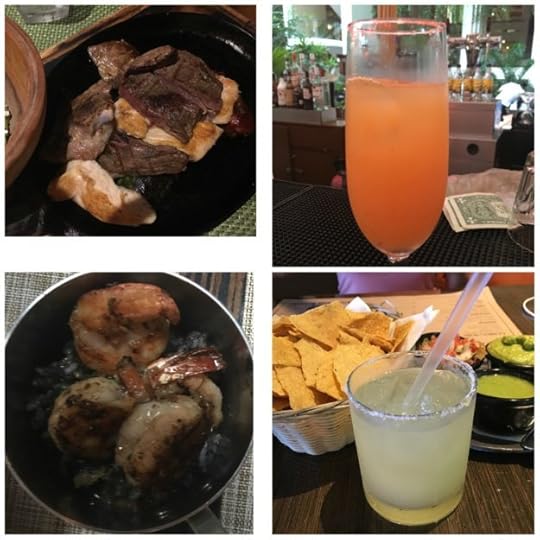
Trips like this are why I love, love, love my job. I can take my work anywhere there is a wifi connection and stay on top of all my work. I didn’t mind at all that I needed to spend my first couple hours of the day working so I could have the rest of the day free.
I’m an early riser by nature, and it was even more motivating to wake up at 5 am and have it be 80 degrees already. I was able to walk down to the beach with my laptop and work.

The cabanas were deserted this time of day, and I was able to sit and watch the gorgeous moon play out over the water and see the sky lighten gradually until the sun was overhead. Nothing increases my productivity more than a gorgeous setting.

When the breakfast buffet opened, I’d head up to drink my 5 pots of coffee and eat the only healthy thing of the day. Egg white omelet and fruit.
I’d spend another hour or so working and then it was off to the beach with Kathy. We’d start counting down the hours until we felt it appropriate to start on the chips and margaritas. That “appropriate” time seemed to get earlier and earlier every day.
The afternoon was all about naps. Yeah, I know…rough life. But we had to work up our energy to eat and drink more at dinner.
There was cocktail hour entertainment with talented musicians where we were able to try several different kinds of drinks. We both agreed we could stay and listen to them play and sing all night. If only there hadn’t been such appealing food we wanted to try.



The resort we stayed in, Paradisus, was wonderful in all aspects. The facility, staff, and food. Especially the food. Each night we got to try a different on-site restaurant, and neither of us could agree upon which was the best. The tapas, the Brazilian steakhouse, or the authentic Mexican restaurant.
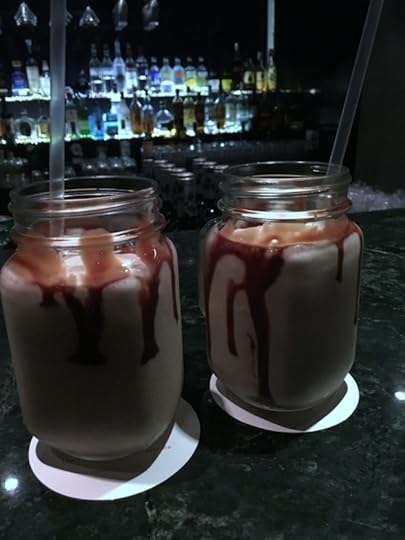
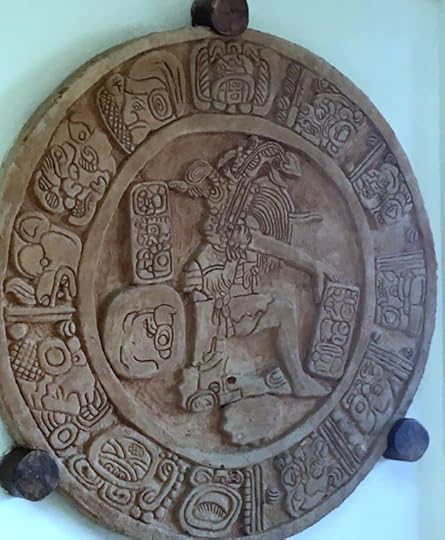
Though I will have to say the mariachi band at the Mexican place was to die for. It created the perfect ambiance.
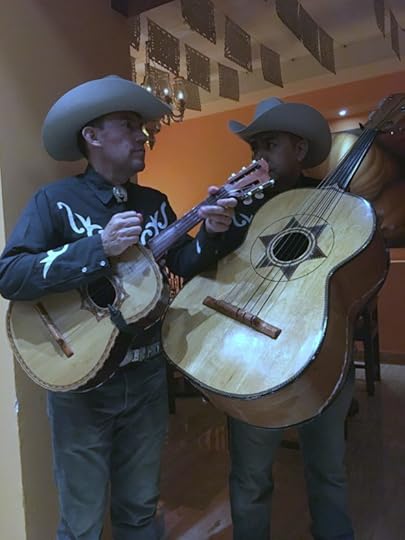
While this has been a year of travel, this trip is the only one that was pure pleasure. All my others this year were (and are) for work. Conferences and such. It was nice to be away from my normal rigorous schedule.
If fact, I had such a good time here that I’d ready to plan another trip with the kids.

The post My Trip To Cancun appeared first on Laina Turner.

May 24, 2017
Results of the Great Weigh In
If you’ve been following my blog at all this year, you might have seen me mention the 14-week Slambam fitness challenge I took on back in February.
It’s a contest that’s not just a weight loss challenge. You’re judged on the percent of weight lost and total body transformation.
I lost 19.8 pounds and several inches. Most people would say I did well.
In fact, all the people in the group, my instructor, my friends all said I did a fantastic job and were proud of me and my motivation and ability to stick to it.
But for me…I felt like a failure.
It’s the same almost 20 lbs I’ve lost a million times in the last 25 years, and the same 20 lbs I lost last year before my wedding. Then promptly gained it back in the 6 months before Slambam started.
I believe most women have a love/hate relationship with the scale even though we all know it’s only a part of the big picture. It’s much more important to be healthy. Not a size 4.
Blah, blah, blah…..
I don’t care how much my objective, rational mind tells me that it’s more important to be healthy then what the scale says my emotions are tied to that freaking scale.
I go up .2, and I feel fat all day which then inspires negativity in my brain, the feeling that why should I bother, I will always be fat, and on and on and on. I feel this way even though right now I know I am the fittest I’ve even been. I’m stronger, I have more endurance, and I feel awesome (physically).
But the head trash, the negative thoughts that spin mourned and around in my head is a totally different story.
How can I be excited about something I accomplished when I’ve had the same accomplishment SO MANY TIMES!!!
How can I be a role model for my daughter when I keep making the same mistake over and over?
How can I push through the fear that once again I will gain this weight back and be fat and ready for next years Slambam?
The answer is simple.
How can I not?
I have a young daughter and step-daughter. I have friends who have young daughters. At 10, 11, and 13 years of age I hear them talk about being called fat at school, feeling fat, asking their moms and me if they are fat. It breaks my heart to hear this come out of their mouths.
I don’t like this negative self-talk in myself or my friends and I certainly don’t wish for our beautiful daughters to think and feel this way.
I need to do my part in instilling in my daughter and the young women around me to be proud of who they are and what they look like.
I MUST celebrate victories to show my daughter that all achievements are to be proud of.
I MUST be a role model and realize that showing her it’s just as important to understand no one is perfect and giving up on any goal isn’t an option. Regardless of the setbacks.
I MUST not worry about the future and instead take each day as a challenge to do what’s right. What I know I need to do for myself, my family, and my health.
We all need to love ourselves as we are because we ARE FABULOUS regardless of our size or how we look in a bikini.
Now go look in the mirror and tell yourself that 10 times. That’s what I’m going to do!
The post Results of the Great Weigh In appeared first on Laina Turner.

May 22, 2017
Why You Should Outline Your Fiction Novel
The answer is yes.
Ok, I know that’s not all that helpful. But it’s not an easy question because there is no right or wrong answer.
My first piece of advice is to use the process that makes you feel most creative, inspired and motivated to write your story. But I also want to say that you need to outline at some point or the likelihood of getting lost in where your plot is going, and flow of your story is high.
It’s very challenging to write 60k plus words without an outline and keep everything straight. It also makes for a much longer editing process as you have to go back and do many rewrites to correct all the mistakes.
Now with that said I admit I am one of those writers whose natural tendency is not to outline my fiction books. When I first started writing, I would have my idea, write my first draft all the way through, and THEN outline. But I finally learned, after years of doing it the hard way, in the end not outlining doesn’t work for me. So even though it’s a chore (in my opinion), I force myself to outline.
Why make the switch even though I don’t want to? Because it’s more efficient and my writing is my business, so I need to be creative AND efficient.
When I don’t outline, I do great out of the gate. Plugging along with my mental notes and timeline in my head. I get to the halfway point and then get stuck at what to do about all the middle part, so I skip to the end. I finish the end and am left with a huge hole in the middle that I am at a total about how to fill. Then I screech to a halt staring at the blank page wondering what should go there. Once I figure out, I usually have to change my ending at least a little for the middle to fit, and that ends up in wasted time. And I hate to waste time.
I wrote my first 10 books that way before I wised up. What can I say? I’m stubborn.
Join me for a FREE 5 day e-course on goal setting
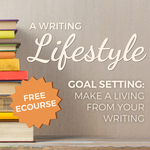
Want to make a living as an author?
Achieving your dream starts with a GOAL!
Let's get started!!
Success! Now check your email to confirm your interest.
There was an error submitting your subscription. Please try again.
First Name Email Address We use this field to detect spam bots. If you fill this in, you will be marked as a spammer. Sign Up NOW Powered by ConvertKit /* Layout */ .ck_form { /* divider image */ background: #fff url(data:image/gif;base64,R0lGODlhAQADAIABAMzMzP///yH/C1hNUCBEYXRhWE1QPD94cGFja2V0IGJlZ2luPSLvu78iIGlkPSJXNU0wTXBDZWhpSHpyZVN6TlRjemtjOWQiPz4gPHg6eG1wbWV0YSB4bWxuczp4PSJhZG9iZTpuczptZXRhLyIgeDp4bXB0az0iQWRvYmUgWE1QIENvcmUgNS41LWMwMTQgNzkuMTUxNDgxLCAyMDEzLzAzLzEzLTEyOjA5OjE1ICAgICAgICAiPiA8cmRmOlJERiB4bWxuczpyZGY9Imh0dHA6Ly93d3cudzMub3JnLzE5OTkvMDIvMjItcmRmLXN5bnRheC1ucyMiPiA8cmRmOkRlc2NyaXB0aW9uIHJkZjphYm91dD0iIiB4bWxuczp4bXA9Imh0dHA6Ly9ucy5hZG9iZS5jb20veGFwLzEuMC8iIHhtbG5zOnhtcE1NPSJodHRwOi8vbnMuYWRvYmUuY29tL3hhcC8xLjAvbW0vIiB4bWxuczpzdFJlZj0iaHR0cDovL25zLmFkb2JlLmNvbS94YXAvMS4wL3NUeXBlL1Jlc291cmNlUmVmIyIgeG1wOkNyZWF0b3JUb29sPSJBZG9iZSBQaG90b3Nob3AgQ0MgKE1hY2ludG9zaCkiIHhtcE1NOkluc3RhbmNlSUQ9InhtcC5paWQ6MUQ5NjM5RjgxQUVEMTFFNEJBQTdGNTQwMjc5MTZDOTciIHhtcE1NOkRvY3VtZW50SUQ9InhtcC5kaWQ6MUQ5NjM5RjkxQUVEMTFFNEJBQTdGNTQwMjc5MTZDOTciPiA8eG1wTU06RGVyaXZlZEZyb20gc3RSZWY6aW5zdGFuY2VJRD0ieG1wLmlpZDoxRDk2MzlGNjFBRUQxMUU0QkFBN0Y1NDAyNzkxNkM5NyIgc3RSZWY6ZG9jdW1lbnRJRD0ieG1wLmRpZDoxRDk2MzlGNzFBRUQxMUU0QkFBN0Y1NDAyNzkxNkM5NyIvPiA8L3JkZjpEZXNjcmlwdGlvbj4gPC9yZGY6UkRGPiA8L3g6eG1wbWV0YT4gPD94cGFja2V0IGVuZD0iciI/PgH//v38+/r5+Pf29fTz8vHw7+7t7Ovq6ejn5uXk4+Lh4N/e3dzb2tnY19bV1NPS0dDPzs3My8rJyMfGxcTDwsHAv769vLu6ubi3trW0s7KxsK+urayrqqmop6alpKOioaCfnp2cm5qZmJeWlZSTkpGQj46NjIuKiYiHhoWEg4KBgH9+fXx7enl4d3Z1dHNycXBvbm1sa2ppaGdmZWRjYmFgX15dXFtaWVhXVlVUU1JRUE9OTUxLSklIR0ZFRENCQUA/Pj08Ozo5ODc2NTQzMjEwLy4tLCsqKSgnJiUkIyIhIB8eHRwbGhkYFxYVFBMSERAPDg0MCwoJCAcGBQQDAgEAACH5BAEAAAEALAAAAAABAAMAAAICRFIAOw==) repeat-y center top; font-family: "Helvetica Neue", Helvetica, Arial, Verdana, sans-serif; line-height: 1.5em; overflow: hidden; color: #666; font-size: 16px; border-top: solid 20px #3071b0; border-top-color: #a7a6a6; border-bottom: solid 10px #3d3d3d; border-bottom-color: #646464; -webkit-box-shadow: 0px 0px 5px rgba(0,0,0,.3); -moz-box-shadow: 0px 0px 5px rgba(0,0,0,.3); box-shadow: 0px 0px 5px rgba(0,0,0,.3); clear: both; margin: 20px 0px; } .ck_form, .ck_form * { -webkit-box-sizing: border-box; -moz-box-sizing: border-box; box-sizing: border-box; } #ck_subscribe_form { clear: both; } /* Element Queries — uses JS */ .ck_form_content, .ck_form_fields { width: 50%; float: left; padding: 5%; } .ck_form.ck_horizontal { } .ck_form_content { border-bottom: none; } .ck_form.ck_vertical { background: #fff; } .ck_vertical .ck_form_content, .ck_vertical .ck_form_fields { padding: 10%; width: 100%; float: none; } .ck_vertical .ck_form_content { border-bottom: 1px dotted #aaa; overflow: hidden; } /* Trigger the vertical layout with media queries as well */ @media all and (max-width: 499px) { .ck_form { background: #fff; } .ck_form_content, .ck_form_fields { padding: 10%; width: 100%; float: none; } .ck_form_content { border-bottom: 1px dotted #aaa; } } /* Content */ .ck_form_content h3 { margin: 0px 0px 15px; font-size: 24px; padding: 0px; } .ck_form_content p { font-size: 14px; } .ck_image { float: left; margin-right: 5px; } /* Form fields */ .ck_errorArea { display: none; } #ck_success_msg { padding: 10px 10px 0px; border: solid 1px #ddd; background: #eee; } .ck_label { font-size: 14px; font-weight: bold; } .ck_form input[type="text"], .ck_form input[type="email"] { font-size: 14px; padding: 10px 8px; width: 100%; border: 1px solid #d6d6d6; /* stroke */ -moz-border-radius: 4px; -webkit-border-radius: 4px; border-radius: 4px; /* border radius */ background-color: #f8f7f7; /* layer fill content */ margin-bottom: 5px; height: auto; } .ck_form input[type="text"]:focus, .ck_form input[type="email"]:focus { outline: none; border-color: #aaa; } .ck_checkbox { padding: 10px 0px 10px 20px; display: block; clear: both; } .ck_checkbox input.optIn { margin-left: -20px; margin-top: 0; } .ck_form .ck_opt_in_prompt { margin-left: 4px; } .ck_form .ck_opt_in_prompt p { display: inline; } .ck_form .ck_subscribe_button { width: 100%; color: #fff; margin: 10px 0px 0px; padding: 10px 0px; font-size: 18px; background: #ff8598; -moz-border-radius: 4px; -webkit-border-radius: 4px; border-radius: 4px; /* border radius */ cursor: pointer; border: none; text-shadow: none; } .ck_form .ck_guarantee { color: #626262; font-size: 12px; text-align: center; padding: 5px 0px; display: block; } .ck_form .ck_powered_by { display: block; color: #aaa; } .ck_form .ck_powered_by:hover { display: block; color: #444; } .ck_converted_content { display: none; padding: 5%; background: #fff; }I realize there are many legitimate reasons to wing it and not outline and I’ve used most of them.
You may feel more creative.
You only write when inspired (which if you want to make a living at this isn’t the best idea either).
Outlining stresses you out.
It makes you feel constrained which slows down the creative process.
But, there are as many reasons you SHOULD outline.
You’ll have a better idea of where you’re going and where you’ve been.
Not as dependent on your “creative juices” flowing. You know what you’re going to write from the start. And that’s handy if you want to be a pro and show up every day to work.
Less chance of having plot holes.
Less chance of inconsistencies that cause you to rewrite a lot of your book.
So, how can you make yourself outline when you’re not used to it?
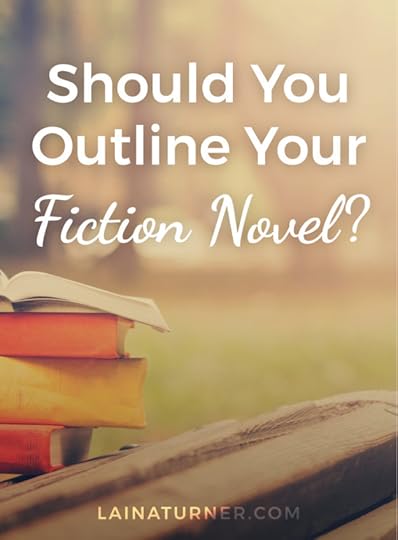
The best way to start something new or unfamiliar is to start. Which we all know is much easier than it sounds.
I like to keep it simple. There isn’t any reason to make anything more complicated than it needs to be.
Most of us writers start with an idea. For me, it’s not always a developed idea. More of a fragment that I then have to create a story around. Which is the best part if you ask me.
Once I have this nugget of an idea I force myself to craft a short paragraph around it. Trying, to sum up the full story in a few sentences. Not easy when I don’t know the full story, but it does force me to put some organization around my idea. I take my time on this part to create a strong summary that I can use to jumpstart my outlining process.
As much as I sometimes dislike this exercise, I make myself do it because it’s useful. I can sit for hours trying to write other elements in with my fragment of an idea to come up with a basic story premise. I toss most of my ideas away but eventually something sticks. Now it might not end up being where my story goes, but it’s something. Something I can start my outline with.
The next step is to take this short blurb and turn it into my outline that will become a 60k plus book.
I start with a simple formula in my head. 60,000 words, divided by 2500 word chapters equals 24 chapters.
Now, none of my books have ever finished meeting that exact formula, but it gives me a place to start.
I grab a new notebook (any of you who’ve read my blogs know I have a bit of an obsession with office supplies), and I write out numbers vertically from 1 to 50.
Using my blurb, I start to plot out my ideas. The goal here is to get as many ideas related to the blurb as I can. I shoot for double the number of chapters because while I do write in a way that one chapter typically equals one scene, I need a lot of extra ideas to make up for all the ones I eventually deem stupid and toss out.
These ideas will include my main overarching storyline and all the subplots. I then set that aside and start brainstorming about the characters who will carry out all these great scene ideas.
I don’t get hung up on names I just write down brief descriptions so I know who is who and can go back and fill in the details later. This first pass on my outline is about the ideas and the flow. I don’t want to get bogged down with the details.
Once I list out all the characters, I can think of to make this story work I go back and start filling in the blanks. It is much easier to insert characters into your story when you start to write it when you know the details about them. It can stop your creative mojo when you get distracted trying to decide what color hair the person should have or their mannerisms. I want these details ready to slip right into the action.
Now, this is where I go off the rails a bit. I can only force myself to outline so much. When I start my first draft, I don’t always go in a linear fashion. I write by time, not word count. Sometimes I skip around to different topics because I’m at a loss with an idea and don’t know how to proceed. This works for me in regards to writer’s block because I don’t obsess over one idea, or lack thereof, for too long. I don’t want to sit and waste the valuable time I have in staring at my screen. But I caution you that I wouldn’t recommend this as it can also through you off and cause more editing, but for me, it’s how I stay writing consistently. It’s a compromise I make with myself when I force the initial outline.
Like anything else, you have to work to change a behavior and learn a new skill. And you do have to use the method that works best for you.
So go! GO WRITE!
The post Why You Should Outline Your Fiction Novel appeared first on Laina Turner.

May 15, 2017
Why You Need a Kick Ass Book Cover
A picture is worth a thousand words and people DO judge a book by its cover.
Cliche and so true.
Look at how Instagram and Pinterest have exploded.
People LOVE images.
Even before the onset of image-driven social media pictures captured people’s attention.
The cover of your book will be the first thing people notice as it’s sitting on the cyber shelves. You need it to stand out and grab people’s attention. To compel them to pick up your book and see what it’s all about.
Your book cover is all about marketing. It’s your first impression. You want that reader stop in her tracks and NEED to buy your book because the cover looks so interesting.
There’s a reason romance novels have half naked men on them.
As you know different writing genres have different cover styles. You won’t see bright colors and an illustrated woman shopping on a horror book or a bunch of robots on a romance novel. Book covers must reflect your genre, so they attract your audience.
Spend some time looking at book covers in your genre. Books by both traditionally published authors and indie authors so you can see what appeals to you. Put your reader hat on and determine what would compel you to try one of those books based on the cover alone. You need to know what’s out there, so you understand what you’re competing against and to know what the trend is.
I’ve spent money in this area duplicating efforts as I have found what I thought looked cool wasn’t selling. I’ve made cover changes that immediately increased sales because the new cover stood out more.
My first books have been through two or three covers because it took me a while to figure out what I was doing. And I don’t have it all figured out by any means.
I’ve had book covers designed where felt I was hitting exactly the elements I needed to reach my audience. But when I revealed it to my readers they hated it, and I had to start over.
It happens.
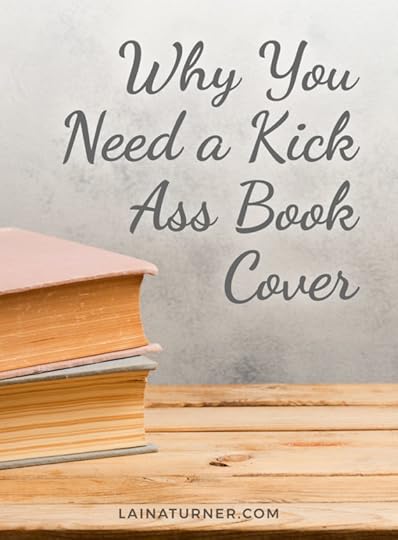
Unless you’re talented in design, this is another area in your business where hiring a professional is worth every penny. As I’ve said before focus your talents where they will be the most effective.
Don’t spend hours and hours on something that might not be all that great. Find someone who knows what they’re doing and outsources certain production elements. Then you can spend your time writing and creating.
A professional graphic designer is someone who understands how to visually appeal to your target audience. They will be able to tell you about different aspects of your cover you may not have thought of. That’s why they’re in the business they’re in because they want to make things pretty and marketable.
For example, I currently have a couple of different series I write. In the beginning, I worked with designers who were very inexpensive as I didn;t have a lot to spend. I thought my book covers were awesome, but each cover in my series looked much different from the other books in the series. There was no continuity. So the average reader wouldn’t know they were a series. It hadn’t even occurred to me that it might be important.
I’m a writer, not a marketer.
Join me for a FREE 5 day e-course on goal setting 
Want to make a living as an author?
Achieving your dream starts with a GOAL!
Let's get started!!
Success! Now check your email to confirm your interest.
There was an error submitting your subscription. Please try again.
First Name Email Address We use this field to detect spam bots. If you fill this in, you will be marked as a spammer. Sign Up NOW Powered by ConvertKit /* Layout */ .ck_form { /* divider image */ background: #fff url(data:image/gif;base64,R0lGODlhAQADAIABAMzMzP///yH/C1hNUCBEYXRhWE1QPD94cGFja2V0IGJlZ2luPSLvu78iIGlkPSJXNU0wTXBDZWhpSHpyZVN6TlRjemtjOWQiPz4gPHg6eG1wbWV0YSB4bWxuczp4PSJhZG9iZTpuczptZXRhLyIgeDp4bXB0az0iQWRvYmUgWE1QIENvcmUgNS41LWMwMTQgNzkuMTUxNDgxLCAyMDEzLzAzLzEzLTEyOjA5OjE1ICAgICAgICAiPiA8cmRmOlJERiB4bWxuczpyZGY9Imh0dHA6Ly93d3cudzMub3JnLzE5OTkvMDIvMjItcmRmLXN5bnRheC1ucyMiPiA8cmRmOkRlc2NyaXB0aW9uIHJkZjphYm91dD0iIiB4bWxuczp4bXA9Imh0dHA6Ly9ucy5hZG9iZS5jb20veGFwLzEuMC8iIHhtbG5zOnhtcE1NPSJodHRwOi8vbnMuYWRvYmUuY29tL3hhcC8xLjAvbW0vIiB4bWxuczpzdFJlZj0iaHR0cDovL25zLmFkb2JlLmNvbS94YXAvMS4wL3NUeXBlL1Jlc291cmNlUmVmIyIgeG1wOkNyZWF0b3JUb29sPSJBZG9iZSBQaG90b3Nob3AgQ0MgKE1hY2ludG9zaCkiIHhtcE1NOkluc3RhbmNlSUQ9InhtcC5paWQ6MUQ5NjM5RjgxQUVEMTFFNEJBQTdGNTQwMjc5MTZDOTciIHhtcE1NOkRvY3VtZW50SUQ9InhtcC5kaWQ6MUQ5NjM5RjkxQUVEMTFFNEJBQTdGNTQwMjc5MTZDOTciPiA8eG1wTU06RGVyaXZlZEZyb20gc3RSZWY6aW5zdGFuY2VJRD0ieG1wLmlpZDoxRDk2MzlGNjFBRUQxMUU0QkFBN0Y1NDAyNzkxNkM5NyIgc3RSZWY6ZG9jdW1lbnRJRD0ieG1wLmRpZDoxRDk2MzlGNzFBRUQxMUU0QkFBN0Y1NDAyNzkxNkM5NyIvPiA8L3JkZjpEZXNjcmlwdGlvbj4gPC9yZGY6UkRGPiA8L3g6eG1wbWV0YT4gPD94cGFja2V0IGVuZD0iciI/PgH//v38+/r5+Pf29fTz8vHw7+7t7Ovq6ejn5uXk4+Lh4N/e3dzb2tnY19bV1NPS0dDPzs3My8rJyMfGxcTDwsHAv769vLu6ubi3trW0s7KxsK+urayrqqmop6alpKOioaCfnp2cm5qZmJeWlZSTkpGQj46NjIuKiYiHhoWEg4KBgH9+fXx7enl4d3Z1dHNycXBvbm1sa2ppaGdmZWRjYmFgX15dXFtaWVhXVlVUU1JRUE9OTUxLSklIR0ZFRENCQUA/Pj08Ozo5ODc2NTQzMjEwLy4tLCsqKSgnJiUkIyIhIB8eHRwbGhkYFxYVFBMSERAPDg0MCwoJCAcGBQQDAgEAACH5BAEAAAEALAAAAAABAAMAAAICRFIAOw==) repeat-y center top; font-family: "Helvetica Neue", Helvetica, Arial, Verdana, sans-serif; line-height: 1.5em; overflow: hidden; color: #666; font-size: 16px; border-top: solid 20px #3071b0; border-top-color: #a7a6a6; border-bottom: solid 10px #3d3d3d; border-bottom-color: #646464; -webkit-box-shadow: 0px 0px 5px rgba(0,0,0,.3); -moz-box-shadow: 0px 0px 5px rgba(0,0,0,.3); box-shadow: 0px 0px 5px rgba(0,0,0,.3); clear: both; margin: 20px 0px; } .ck_form, .ck_form * { -webkit-box-sizing: border-box; -moz-box-sizing: border-box; box-sizing: border-box; } #ck_subscribe_form { clear: both; } /* Element Queries — uses JS */ .ck_form_content, .ck_form_fields { width: 50%; float: left; padding: 5%; } .ck_form.ck_horizontal { } .ck_form_content { border-bottom: none; } .ck_form.ck_vertical { background: #fff; } .ck_vertical .ck_form_content, .ck_vertical .ck_form_fields { padding: 10%; width: 100%; float: none; } .ck_vertical .ck_form_content { border-bottom: 1px dotted #aaa; overflow: hidden; } /* Trigger the vertical layout with media queries as well */ @media all and (max-width: 499px) { .ck_form { background: #fff; } .ck_form_content, .ck_form_fields { padding: 10%; width: 100%; float: none; } .ck_form_content { border-bottom: 1px dotted #aaa; } } /* Content */ .ck_form_content h3 { margin: 0px 0px 15px; font-size: 24px; padding: 0px; } .ck_form_content p { font-size: 14px; } .ck_image { float: left; margin-right: 5px; } /* Form fields */ .ck_errorArea { display: none; } #ck_success_msg { padding: 10px 10px 0px; border: solid 1px #ddd; background: #eee; } .ck_label { font-size: 14px; font-weight: bold; } .ck_form input[type="text"], .ck_form input[type="email"] { font-size: 14px; padding: 10px 8px; width: 100%; border: 1px solid #d6d6d6; /* stroke */ -moz-border-radius: 4px; -webkit-border-radius: 4px; border-radius: 4px; /* border radius */ background-color: #f8f7f7; /* layer fill content */ margin-bottom: 5px; height: auto; } .ck_form input[type="text"]:focus, .ck_form input[type="email"]:focus { outline: none; border-color: #aaa; } .ck_checkbox { padding: 10px 0px 10px 20px; display: block; clear: both; } .ck_checkbox input.optIn { margin-left: -20px; margin-top: 0; } .ck_form .ck_opt_in_prompt { margin-left: 4px; } .ck_form .ck_opt_in_prompt p { display: inline; } .ck_form .ck_subscribe_button { width: 100%; color: #fff; margin: 10px 0px 0px; padding: 10px 0px; font-size: 18px; background: #ff8598; -moz-border-radius: 4px; -webkit-border-radius: 4px; border-radius: 4px; /* border radius */ cursor: pointer; border: none; text-shadow: none; } .ck_form .ck_guarantee { color: #626262; font-size: 12px; text-align: center; padding: 5px 0px; display: block; } .ck_form .ck_powered_by { display: block; color: #aaa; } .ck_form .ck_powered_by:hover { display: block; color: #444; } .ck_converted_content { display: none; padding: 5%; background: #fff; }Then it was explained to me why from a marketing standpoint it was important to have my series branded. For all the books to look like they were part of a collection. It made perfect sense. Once he said it, I realized all my favorite authors have that continuity within their series. It just didn’t occur to me until my cover designer brought it to my attention. I’d always been more concerned about the pretty in my individual book covers rather than functionality or marketability. But they aren’t sweaters; they’re sales brochures.
Covers need to help sell your book.
Each platform you sell your book on, and the various social media platforms will have different expectations of cover sizes to upload to the platform. Something I didn’t think of until I tried to upload my covers to Audible and put a header on my Facebook Fan page. Because I didn’t have the right size, none of my old book covers looked good.
You will need your cover in all the formats because your cover art is your product packaging. It needs to look great in every single place you put it.
After all the hard work you put into the writing aspect, you owe it to yourself to put a great cover on it!
The post Why You Need a Kick Ass Book Cover appeared first on Laina Turner.

May 8, 2017
Back to the Basic Elements of Fiction
I’m a firm believer in keeping things as simple as possible. As a novelist, it’s easy to get sidetracked from the basic elements of fiction. These are the elements which create a great story and have proven to work over the years.
Getting away from what works often causes problems. #writerproblems
Do you have writer problems?
Do you ever get stuck on what to write next?
You’re not sure how to start your next chapter?
You find your middle is lagging and boring?
You’re out of ideas on how to connect the dots between one subplot and another?
These are all common ailments of an author.
When this happens, and it does to all authors at some point, you need to stop, take a deep breath, and refocus.
Don’t let the character voices in your head get to you. You might need to put your foot down and remind them they obey you not the other way around.
It’s always a good idea for even the best writer to revisit the basics of fiction once in a while. You might be thinking but I’ve already written a book, or 5, isn’t this wasting time? I know the basics!
Do you think Michael Jordan stop revisiting the basics once he became awesome?
No. He kept at it trying to get better and better and look what it did for him. He got cut from his high school basketball team and still went on to be the best basketball player of all time.
I’m not a sports fan, but I love this quote.
“The minute you get away from fundamentals – whether it’s proper technique, work ethic or mental preparation – the bottom can fall out of your game, your schoolwork, your job, whatever you’re doing.” – Michael Jordan
Never move away from the basics. They are the basics because they work. Awesome careers are built on the basics.
There are several different ways to approach writing while sticking to those basic elements of fiction. And no one way is better. You need to find what works for you and your story.
I like simple. I’m no Tom Clancy or a Steig Larsson with tons of complexity to my stories. I rarely write from a strict outline when I’m writing fiction (which isn’t a good idea but more about that in another post). But I keep in mind that each chapter needs to have a setup, a rising stake, and a resolution.
Although the resolution may not be completely apparent to the reader until the start of the following chapter. You want to leave them wanting more and keep them turning the page.
There have been several times where I haven’t been happy with a draft of a book, and when I reviewed it to make sure I had the basic set up, rising stake, and resolution, it was easy to spot where I went wrong.
Which I know can sound crazy. It’s 3 elements, not 150 but when my mind is churning out ideas one right after another, I can’t help it. I get off track because I have so many great ideas that I’m trying to get down on paper. They get all jumbled up and there isn’t fluid movement within the chapters and between them.
Hence why I need to outline more. Save yourself frustration authors.
Do as I say not as I do and OUTLINE.
In a book, there is the main beginning, a middle, and an end. And then all the smaller subplots within the overall plot. There is a lot going on in a book, and it can be hard to keep it all straight.
When you start a book, you usually know the main story structure. If not make sure to plan that out first.
It’s the subplots that can get you easily off track because you weave them in and out of your main plot. Sticking with the basic elements of fiction can make your life so much easier when it comes to staying on track to your plot.
My method is super technical. I use post it notes to keep my thoughts straight. I go to this spot in my house where it’s blank (which is almost any spot – we moved in 2 years ago, and I still haven’t gotten around to decorating) and I write down my plot idea and stick it on the wall. I keep this up, posting them in a horizontal line to keep them neat until I’ve exhausted all my ideas.
Once I have all the main ideas for the particular book I’m working on out of my head I get a different color post-it pad (this step is very important). Under each main idea, I write down the small parts that will make up this main idea. Then put them on the wall in a vertical column under the main idea. It gives me the working pieces of each of my ideas and Voile each vertical column is a loose scene outline.
It’s not a fancy method, but it works.
It gets the ideas out of my head in a somewhat orderly fashion. I then take a picture of the post-its so I can refer to them when I get stuck. I’d leave them up, but my kids think its fun to move them around and make me feel like I’m going insane.
While this is my method, and I’ve used it for years, I love to hear what other people do. So please share in the comments.
The post Back to the Basic Elements of Fiction appeared first on Laina Turner.




